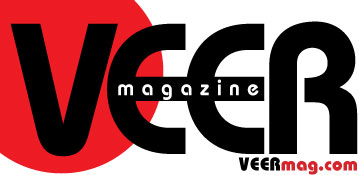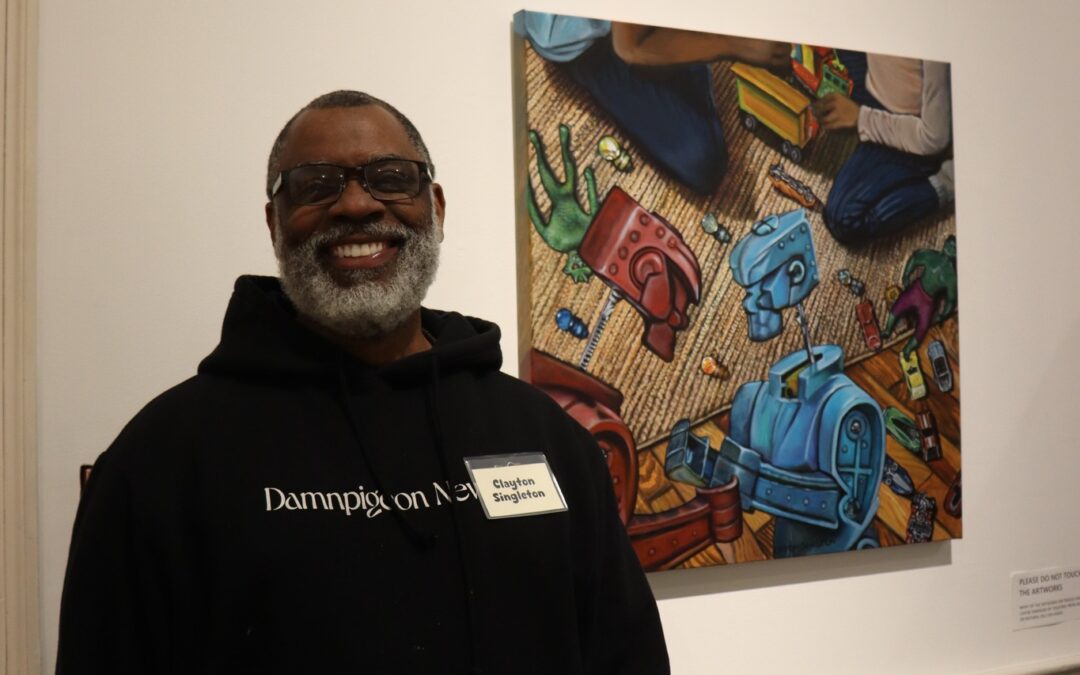(Artist Clayton Singleton has some fun with his Rock ‘em, Sock ‘em Robots painting as part of the exhibition “Playtime: Toys and Art”)
By Betsy DiJulio
Toys turn adults into time travelers, telescoping us back to the people, places, and passions of childhood. For children, though they may not be aware, playing with toys fuels the imagination while teaching skills and, at times, providing comfort and security.
Technically, a distinction exists between toys and games, as toys are associated with imaginative play, free of rules and goals, while games are more structured, accompanied by clear instructions, guidelines, and objectives, often competitive and often requiring cooperation. From a sociological perspective, the colors and materials, styles, and subjects of iconic toys are clues to the zeitgeist of an era, capable of generating strong nostalgia responses in adults.
For these and other reasons—like providing summer fun for visiting families—a toy-related exhibition and interactive makerspace had long been a twinkle in the eye of curator Diana Blanchard Gross. As she conceptualized the exhibition, she chose not to draw hard lines between the categories, even including what could be thought of as sports equipment. And she cast the net fairly wide in terms of how the artists use toys, e.g. some paint them in still life compositions, some make their art out of toys, and others fabricate actual toys. In addition, she selected artists who were already working with toys, while inviting others to roll the dice, so to speak.
Corinne Lilyard-Mitchell began painting toys in graduate school when she needed plentiful subjects to paint. One of her children was still young, so her floors were strewn with toys seemingly waiting to be pressed into service. Later, as a professor at TCC and still in need of abundant, accessible, and inexpensive subjects for students to paint in order to teach them color theory, color mixing, and composition, she became known for, among other things, her elaborate and highly recognizable still life setups of toys with dramatic lighting. In fact, as a retired professor who now teaches small group lessons in her private studio, she still is.
Though she claims the evocative arrangements of objects aren’t intentionally metaphorical, only the most literal-minded among us could not help but read meaning into these tangled, but aesthetically calculated, constructions.
Spencer Tinkham’s, “Almost Ate It” (2020) is a dynamic piece from his skateboard series. With a propensity for breathing new life to discarded urban materials, the artwork is made of snapped skateboard decks scavenged from Norfolk’s skate parks and Cardinal Skate Shop; its title both an old skater term and a play on predator-prey relationships. The piece began its life as a drawing on a Coca-Cola napkin that Tinkham sat on for months before deciding to laboriously rework the salvaged boards.
The seemingly random subject holds personal significance. While a student at Baylor College in Dallas, TX, the artist became smitten with roadrunners, having never previously seen them in person, though having loved “The Road Runner” cartoon as a kid. In this piece, a roadrunner is chasing an Eastern collared lizard, a natural part of the road runner’s diet, who can, rather humorously, run on his hind legs. The chase occurs down a sloping broken deck upheld by cactus and a striated rock formation, the result of a little-known fact: that skateboards are made of dyed and laminated layers of wood.
Tinkham exploited these layers—more noticeable when the deck is broken—and the fraying of the board to suggest movement. Under the tail of the bird is a collage of stickers he meticulously scraped off the underside of the board, an instance of the “ton of prep work” necessary to transform ordinary skateboards into extraordinary artistic statements.
Lisa Melita, a full-time ceramicist for the last 25 years, contributed both functional and sculptural pieces to the show. A regular on the outdoor festival and art show circuit, she describes her ramen bowls as one of her biggest sellers. Even though she produces them by the dozen, she wants buyers to take home a one-of-a-kind piece of art. So, she inscribes the bottom of each with a unique fortune. Meanwhile, more visible is the surface design of the bowl—here accompanied by a chopsticks rest, mug, saucer, and triangular platter—for which she developed a resist technique for painting images of bright yellow, red, and blue Legos outlined in white against a black background.
A collection of vintage plaster molds (c. 1950s-1970s) that she describes as “cultural commentary…bits of Americana” are the basis for pieces like “Nobody Puts Baby in the Corner” with its doll heads and revolvers. Describing her ceramic assemblages as “whimsical” on the surface but with social commentary hovering just below, this piece is about what she sees as our growing inability to resolve conflict in ways that even approach civility.
WANT TO SEE?
Playtime: Toys and Art
Through August 23
Charles H. Taylor Art Center, 4205 Victoria Boulevard, Hampton, VA, 757.727.1490
www.hamptonarts.org/the-charles-h-taylor-visual-arts-center/exhibitions




